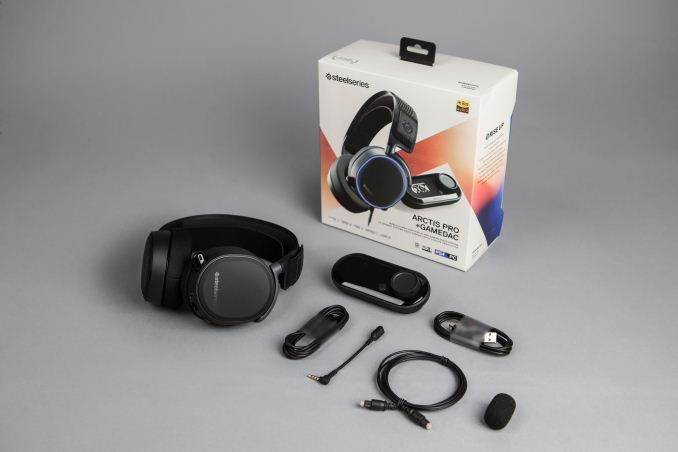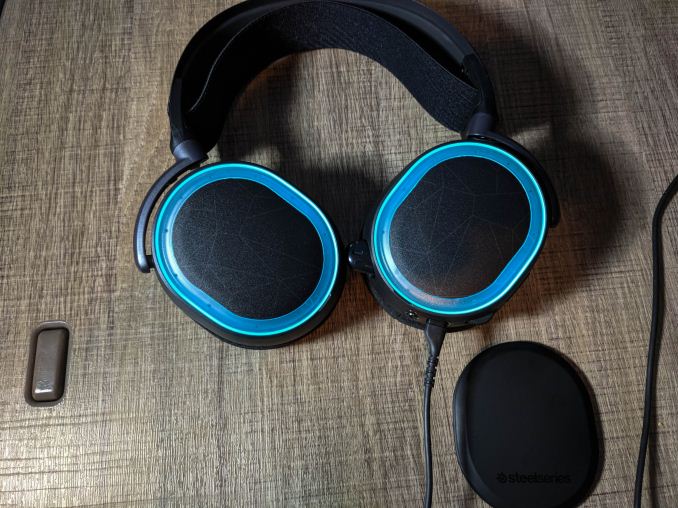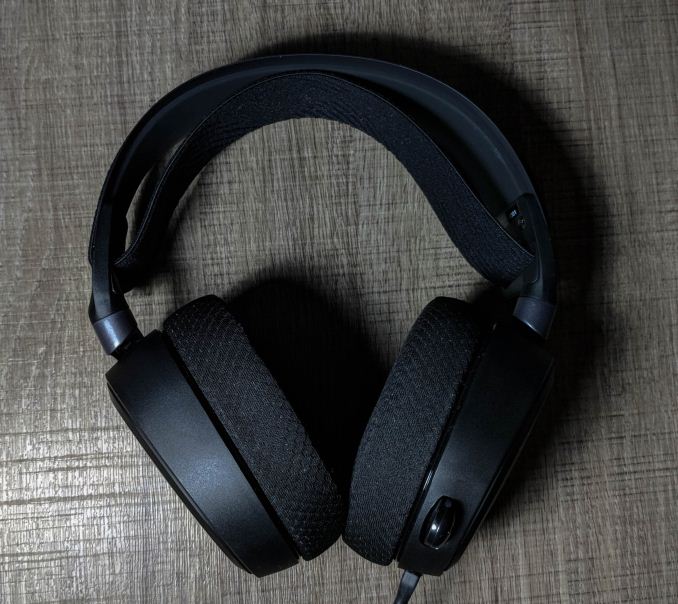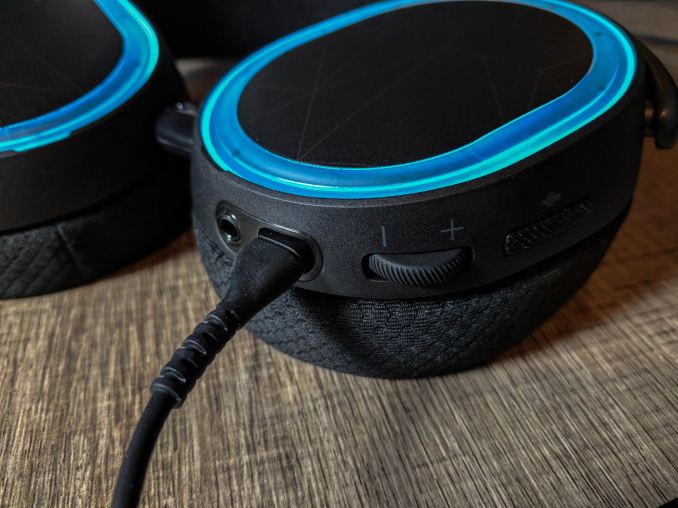The SteelSeries Arctis Pro Gaming Headset Lineup: GameDAC Or Wireless
by Brett Howse on March 13, 2018 9:00 AM EST- Posted in
- Headset
- Audio
- SteelSeries
- Accessories
- Arctis Pro
Arctis Pro Headset
If you’ve seen anything in the Arctis lineup of headsets from SteelSeries, you’ll notice right away that the Arctis Pro doesn’t go in a whole new direction in terms of styling compared to the other models in the Arctis line, and that’s not a bad thing. For those that like an understated look, Arctis definitely fits the bill. The headset is mostly black, with some gray accents on the hangers and strap, but the styling is muted, which looks great.
You can’t get an accessory anymore without some sort of RGB lighting, and the Arctis Pro features LED lighting around the outer edges of the speaker plates. The lighting, and effects, can be adjusted right in the GameDAC itself, or through the SteelSeries Engine Software, but it’s points to SteelSeries for not requiring the software to configure anything on the headset.
For those that do want a bit more edge to the styling, the speaker covers are just held on with magnets, and can easily be removed, which shows off more of the LED lighting, as well as a spiderweb design underneath. If you’d like to mix it up, SteelSeries also sells additional accessories for the headsets to customize the look a bit more.
The top strap has been slightly redesigned from the previous Arctis lineup based on customer feedback, and it features a “Ski Goggle Headband” with an adjustable strap, which lets you easily set the height the headset sits when being worn. The band provides even pressure, and overall, it’s very comfortable. The strap itself was perhaps a bit too tight when right out of the box, but a couple of weeks in and the pressure is much better.
The ear cups features “AirWeave” ear cushions, which, as the name implies, offers breathability when wearing the headset. There’s no problem with heat even after wearing them for several hours at a time. SteelSeries does offer a velour, as well as a leather ear cup, if you’d prefer that, but the AirWeave versions that come in the box are excellent.
All of the controls are on the left ear, and there’s not many since this is a wired headset. There’s a mute toggle switch, a volume knob, and the connectors. To connect to the GameDAC, the headset uses a proprietary cable which is close in size to a mini USB connector. This is in-line with the rest of the Arctis lineup, which also uses the same cable on the wired models. The cable itself is fine, but an improvement SteelSeries could have made would be to use a USB-C cable, which would be standard and easier to obtain if the original is damaged. The company does sell replacement cables on their website though, so if you do need a cable, it’s possible to get one.
The left ear cup also features a 3.5 mm input, so you could connect directly from any device, and in addition, SteelSeries ships an adapter cable from their own cable to 3.5 mm, making it very easy to hook up to a phone or other device which features a 3.5 mm jack. Here, again, USB-C would have been nice since you could also hook up to devices which have dropped the headphone jack.
Finally, there’s the bidirectional ClearCast microphone, which pulls out of the left ear cup on a flexible pole, and winds back up when not necessary. There’s a red LED on the microphone which turns on when the microphone is muted, so there’s never any doubt as to whether the microphone is enabled or not.
The build quality if the headset is very good. There’s no creaks or groans when putting the headset on, or taking it off, and features like the aluminum speaker hangers not only provide plenty of stiffness, but they keep the device weight down.
Overall, the experience with the headset has been very good, although there are a couple of small issues with the experience. First, the location of the volume and mute buttons on the back of the headset are right where your hands would naturally go when taking off or putting on the headset, so from time to time you’ll bump the buttons, which may turn on the red LED on the microphone, or raise or lower the volume.
The volume is the second point which could use some work. Unlike the volume control on the wireless model (which we’ll discuss soon) the GameDAC and headset have separate volume controls. What that means is that you can turn up the GameDAC to maximum, but you still won’t hear anything, and that’s because the volume on the headset is too low. It would be a better user experience if there was just a single volume control, especially when you bump the volume knob when removing the headset, and it can take a couple of seconds to realize why everything is so quiet. If the volume on both the GameDAC and the headset were tied together, that problem would be eliminated.
Finally, the Arctis Pro is a closed back design, which is great for isolation, but it would be nice to see an open back model as well, for those that do need to keep some connection to the real world, even if we don’t want to.














32 Comments
View All Comments
aleny2k - Wednesday, March 28, 2018 - link
This is an un-sponsored comment made by my own personal opinion, and speaking on behalf of many people out there who just read this article/hands-on/review, benefited from it, but kept silent or does not give any feedback: I really do enjoy reading through this article and I do learned a lot of information that was not given directly by the manufacturer (and information which cant be found on other websites). Although I must say I was actually hoping there would be more comprehensive content and in-depth review, but since this article never did set out to be a review nor hands-on in the first place, all is forgiven. Please keep up the good work and hopefully, this will not be the last time you dip your toe in the water for headphones.blackmagnum - Thursday, March 15, 2018 - link
Check techpowerup for a second opinion on the same product.Dr. Swag - Tuesday, March 13, 2018 - link
Is this sponsored? Because it sure feels like it but it doesn't say so...Ryan Smith - Tuesday, March 13, 2018 - link
No, it's not.Brett is a closest audio enthusiast and wanted to try out some headphones. That's all.=)
JDBeast - Thursday, March 15, 2018 - link
Almost lost me at the very beginning..."the GameDAC, which is a USB DAC (Digital Audio Converter)"
DAC is Digital-to-ANALOGUE Converter, it's not just used for audio, though that is most common.
Luckily I checked later in the article and it looks like this was a first draft error, as it is correctly explained in the GameDAC section.
JDBeast - Thursday, March 15, 2018 - link
Also I would be curious to know if they have address the screen burn issues with their oled displays. I have the Steelseries Wireless N with basically the same breakout box and it has bad screen burn after a couple of years use. It doesn't affect performance in anyway (of course) but it looks bad and has ruined the resale value of my headset.Brett Howse - Saturday, March 17, 2018 - link
DAC can be referred to as either, but I prefer the original Digital to Analog Converter. I had been reading some press material which referred to it as Audio Converter which made me type that - I fixed it now.halcyon - Friday, March 23, 2018 - link
For those who are wondering... The GameDac is a 2 channel soundcard for Windows.This means it can NOT do proper mutichannel to 3D sound virtualization as ir is being fed only stereo signal.
It will not be able to do proper front to back identification of sounds in 3D games, unlike DTS Headphone (Asus), Creative Sound Blaster 5.1/7.1 cards or Sennheiser GX1000 series.
All it can do is some pseudo room feel with echo/reverb/phase.
i.e. not a true, high end, 3D sound card.
The article should make this very clear.
TechPowerUp review author rates GameDAC below all modern multichannel 3D virtualization sound carda foe gaming directional cues.
Thats what matters in 3D and FPS games.
aleny2k - Wednesday, March 28, 2018 - link
Hi Brett, thank you for the informative hands-on of this product, information which was not provided by their official website or other sites for that matter. I enjoyed it very much. I do have a question about the Arctis Pro Wireless. You did mention that it can be used wired through the gameDAC as well. My question is, do you get exactly the same audio quality (and hi-res Audio) that you get from Arctis Pro+GameDAC, when you wire your Arctis Pro Wireless to the GameDAC? Steelseries is claiming they are using the same speaker and driver for all their Arctis Pro models. Just that because the wireless variant is wireless, it has more noise and distortion and could not achieve the same high audio fidelity as the wired edition (even though SS claimed that wireless can produce lossless audio), mainly because wireless signal is compromised (compressed and distorted) as well as the built-in DAC found INSIDE the Arctis Pro wireless simply isnt ESS Sabre 9018. Technically, when using the wireless headset through the 3.5mm analog wire, it bypasses the built-in DAC found inside the headset, thus emitting the native audio signal from the source without being tampered by the DAC. But since I dont have the headset to test with, I was wondering if you have some answers for this question. I do have a separate DAC and also a couple of audio devices that are capable of producing lossless, hi-res audio. So I was wondering if the Arctis Pro wireless can behave EXACTLY like the Arctis Pro+GameDAC when being used wired. thank you!!Brett Howse - Sunday, April 1, 2018 - link
The Wireless model has the exact same drivers, and the same connectors as well, so you can just plug it in as if it was the wired model and it does bypass the built-in DAC. You can run it without turning on the battery powered circuitry so it sounds just like the wired model when hooked to the DAC.You can also use a 3.5 mm if you want to do the same thing.